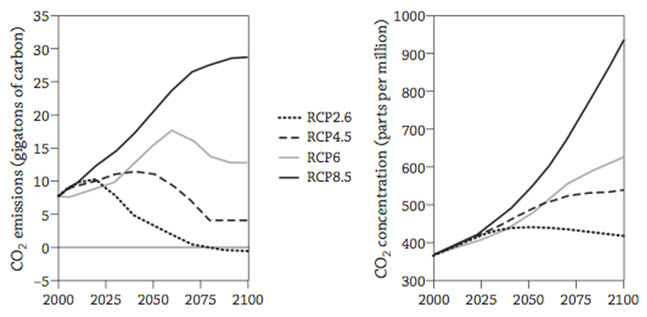Every teenager learning to drive knows the concept of stopping distance: how far a fully braked vehicle will travel before stopping. Depending on conditions, you might stop in 12 feet or two hundred. It depends especially on the speed of the car; a fast moving, heavy car with a lot of momentum will take a long time to stop.
Reaction time matters too; an alert driver can see an obstacle and hit the brakes in about a second and a half. If she brakes too hard, she’ll enter a skid. The vehicle will lose traction and take even longer to stop. We demand all 16-year-olds learn these lessons: 1) it takes a while to stop, and 2) poor judgment will lead to a dangerously counter-productive skid.
Climate change is just the same: it won’t stop suddenly. It’s got planetary mass, after all, and climate change is speeding along very quickly. Suppose the governments and people of the world somehow found the will to stop producing excess CO2. Suppose we did this today, freezing CO2 emissions at their present levels. It would still take decades for extra CO2 to be scrubbed from the atmosphere. This is part of the climate change stopping distance.
The Intergovernmental Panel on Climate Change has been thinking about what it will take to reduce the impact of climate change, and the consequences of failure. It plotted out a number of scenarios, projecting various approaches to carbon emissions. In two possible futures, dubbed RCP6 and RCP4.5, emissions begin declining by 2040 or 2060 and drop below present levels by the optimistic date of 2100. [1] (See figure on left below.) But CO2 content in the atmosphere will not stop dropping by the year 2100; it will take another century or more for CO2 levels to drop. So, the stopping distance for climate change is at best 50 to 100 years.
We have a few decades from now to come to grips with CO2 emissions and haul them back down to levels of previous centuries. Even if we do, from that point, CO2 continues to increase for 50 years, increasing the impact of climate change for that whole time. But beyond 2100, under this scenario, the trajectory of CO2 and climate is more hopeful, and some species, some corals, some rain forests, may be beginning to recover. We can make the 22nd century a century of climate recovery. But only by acting by the mid-21st century.

Figure: Predictions of CO2 emissions (left) and CO2 levels (right) based on various future scenarios of global response to climate change. The RCP 8.5 scenario (solid line) is currently the most likely as it represents no future controls on emissions. This scenario would lead to an exponential increase in oceanic CO2 with serious impact on global life from about 2100 onward. Only if CO2 emissions were to begin to decline by 2020 (for example in the RCP 2.6 scenario (dotted lines)), would CO2 in the atmosphere begin to decline by 2100. Intermediate scenarios (RCP 4.5 and RCP 6.0) would see CO2 levels increasing for the foreseeable future. Figure from S. R. Palumbi and A. R. Palumbi, Extreme Life of the Sea, Princeton U. Press. 2014.
The stopping time for climate change, like the stopping time for a car, is longer the faster your vehicle plummets toward its doom. And the longer we wait, and the more severe the climate damage, the longer the stopping time. Waiting until ecosystems are collapsing at the end of the 21st century would impose something like a century more of stopping distance. And the continued ecosystem damage during that 100 years of extra stopping period would create even more havoc, pushing more species past their extreme limits, and pulling more ecosystem services out from under the human economy, as one species after another slammed up against its ecological limits. Even a controlled braking couldn’t save our metaphorical car from a shattering accident. Remember: even a teenager knows to stop before skidding.
The good news is that by applying the brakes, our civilization might arrive at a gentle non-skidding halt. The bad news is that, if we don’t, we will exhaust the ability of the Earth to pay the climate tax by 2100, and after that the world will collapse ecologically.
A reasonable timeline for action looks like this. First, set a goal to plateau atmospheric CO2 levels by 2100 because if we do not, then climate meltdown is likely to ensue. Second, to achieve this goal, CO2 emissions need to drop to low levels by 2050. That gives us 35 years to replace most fossil fuels with renewables—about 3 percent replacement a year and another 2 percent increase for economic growth. Is 5 percent higher renewable power each year achievable? This is the challenge we face to bring climate change effects to a screeching halt. And that is the challenge that the political, social, technical, and financial sectors of our society should take up.
Stephen R. Palumbi is the Jane and Marshall Steel Professor of Biology at Stanford University. He is a Senior Fellow with the Stanford Woods Institute for the Environment and the Director of Stanford’s Hopkins Marine Station in Monterey working on the way marine species adapt to climate variation. He and Tony Palumbi are co-authors of the recent book Extreme Life of the Sea (Princeton University Press).
[1] Van Vuuren, D. P., Edmonds, J., Kainuma, M., Riahi, K., Thomson, A., Hibbard, K., … & Rose, S. K. (2011). The representative concentration pathways: an overview. Climatic Change, 109(1-2), 5-31.



Commentary
Stopping Distance: What Every 16-Year-Old Knows about Climate Change
July 8, 2014